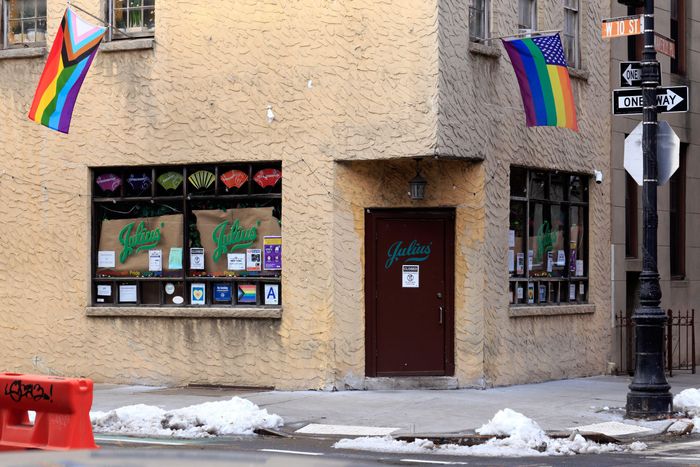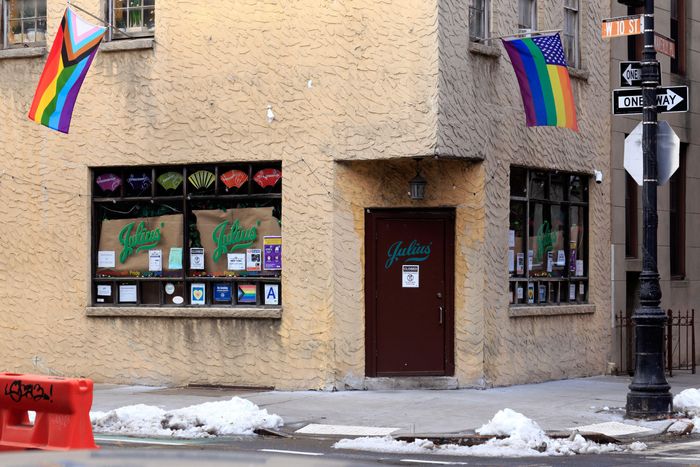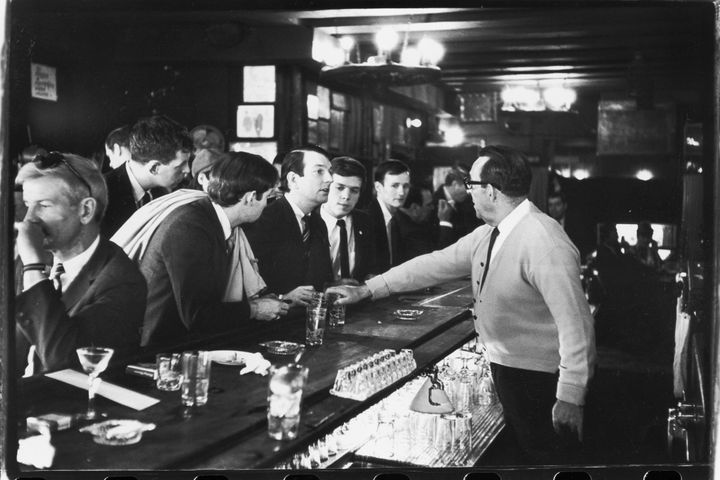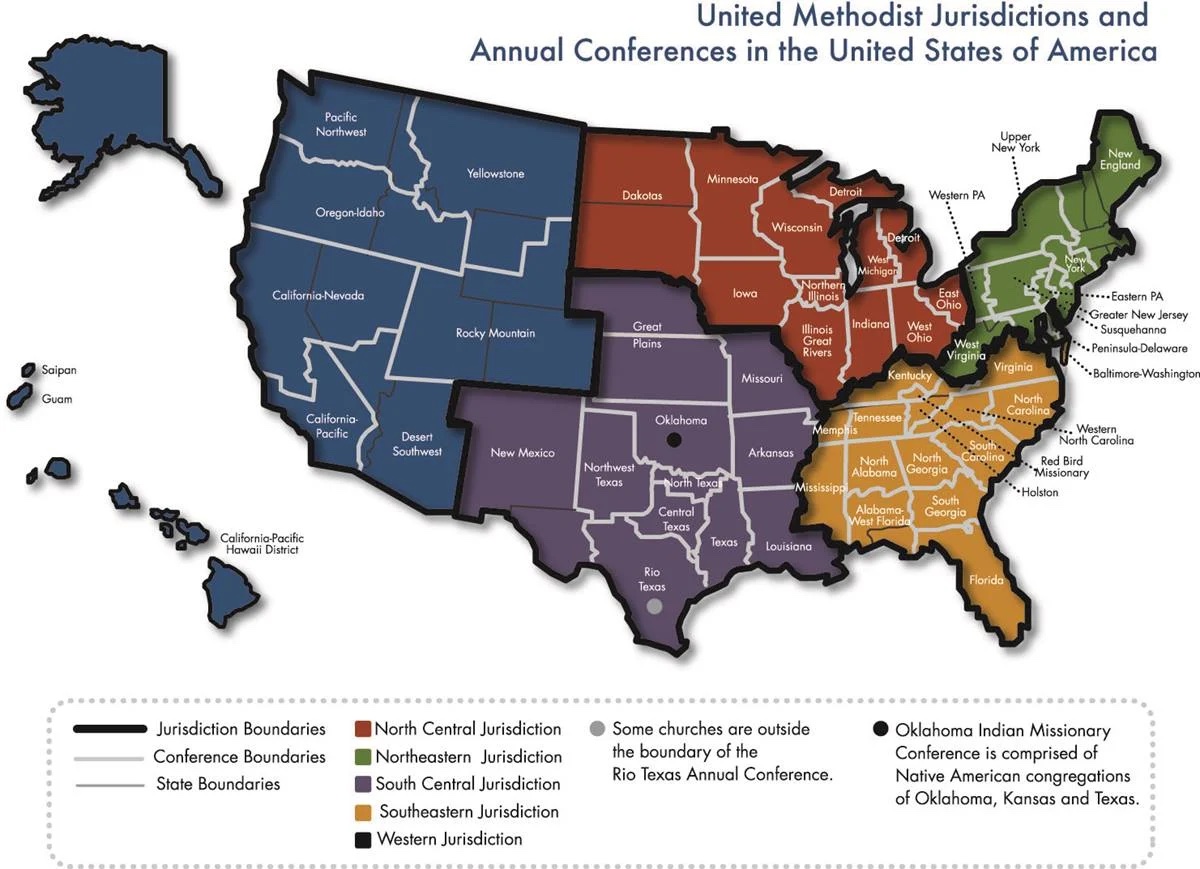
Stucco and the Sip-In, now an official landmark. Photo: Robert K. Chin/Alamy Stock Photo
To those who know, Julius’ is already a landmark. The city’s oldest continually operating gay bar, with its stucco-petalled exterior and permanent perfume of sizzling burger fat, still fills up every night. Julius’ (with an apostrophe, please) is “the definitive ‘fit in the fabric of the neighborhood’ bar,” this magazine wrote — in 1980. By that point, Julius’ was 50 years (not all of them gay) into its comfortable tenure as agreeably grizzled, here-and-there greasy local. Back then, it was still a place where the doors opened at 8 a.m. for “a few old hags who guzzle their breakfast gin free of charge.” These days, the doors open at four (noon on the weekends) and there are still a few hags but also bopping twinks exploring the city via TikTok among the graying fixtures, many with rent-stabilized apartments — the Village having turned from gay ghetto to bankers’ brunch zone long ago. The whole scene is unusually friendly and low-key.
This week, the New York City Landmarks Preservation Commission confirmed what we know, officially designating the bar a New York City landmark following its listing on the National Register of Historic Places in 2016. It joins the nearby Stonewall Inn, which was so honored in 2015. The Commission approved Julius’ not for its burgers or strong well drinks but specifically for its role in advancing LGBTQ+ rights, noting that it was the site, in 1966, of a peaceful protest known as the “Sip-In.” On April 21, three gay men, members of the gay activist organization the Mattachine Society (namesake of the parties run by John Cameron Mitchell), protested State Liquor Authority guidance against serving homosexuals by openly declaring themselves and ordering drinks in front of a journalist and photographer. A Times story the next day was headlined “3 Deviates Invite Exclusion by Bars,” and it noted that the “deviates” actually had to visit a few places before finding one that refused them. The Ukrainian-American Village Restaurant on St. Marks Place, which posted a sign reading “IF YOU ARE GAY, PLEASE GO AWAY,” was unfortunately closed; the manager of the Howard Johnson’s on Sixth Avenue, well-known as a pickup spot, unhesitatingly brought them three bourbons. (“I drink,” he told the reporter, “and who’s to say whether I’m a homosexual or not.”) With this designation, the Sip-In has been officially written into municipal civil-rights history. Technically speaking, the building already sat within the Greenwich Village historic district, which offers it protection from demolition, but that’s been the case since April 1969 — two months before the Stonewall uprising.
The breakthrough moment at the Sip-In, April 21, 1966. Photo: Fred W. McDarrah/MUUS Collection via Getty Images
It has been a long time since so-called deviates were refused service at Julius’, or for that matter any other bar in this great gay city, but the recognition is still a happy one. “Julius’ history is particularly special because it really embodies so many different important threads of Greenwich Village history, LGBTQ history, civil-rights history, and activism,” says Andrew Berman, the executive director of Village Preservation. “The Sip-In in particular struck us as something that was so profoundly ahead of its time and didn’t really have the attention and due that it deserved.” Due delivered: “The ‘Sip-In’ at Julius’ was a pivotal moment in our city and our nation’s LGBTQ+ history, and this designation today marks not only that moment but also Julius’ half-century as a home for New York City’s LGBTQ+ community,” Eric Adams said in a press release issued by the LPC.
Julius’ history extends beyond those fifty years. The space has housed a bar since the 1860s, and Julius’ in particular since the 1930s. Before it settled in as a gay landmark, it was a hangout for newsmen like Walter Winchell, and the tabloid-photographer-auteur Weegee used to pick up messages and mail there in the 1940s. These days, the queer clientele more or less sets the tone. The jukebox leans diva.
Even recently, this wasn’t consistently the case. When Julius’ current owner, Helen Buford, and her late husband, Eugene, bought the bar in the late ’90s, it was, to put it politely, hobbling. “Some of the customers would say, ‘Oh my God, Julius’ was the bar that you would go to when you were, like, ready to die,’” Buford told me. “Young people didn’t want to come in. It’s like one step to the grave, they would say.”
Joe, the bartender at Julius’, as seen by his regular patron Weegee circa 1945. Photo: Weegee (Arthur Fellig)/International Center of Photography/Getty Images
Buford and her husband set about bringing the bar back from the brink. “It was, most of the time, just the old guard,” Paul Dawson, who hosted the Mattachine parties with Hedwig auteur (and longtime rent-regulated Village resident) John Cameron Mitchell, told me earlier this year. “If anybody younger did come in there, they were assumed to be trade.” But that party helped to turn things around. The trade receded, mostly. The bar bounced back. Buford and her husband, a straight couple, may have seemed unlikely to renew one of the city’s queer institutions, but their interest was initially practical: Eugene Buford had worked in bar security before becoming an owner, and gay bars offered business with fewer fights than their straight counterparts. (The Bufords also owned the now-shuttered gay bars Two Potato, on Greenwich Street, and the Bike Stop uptown.) “You don’t have the stupid issues — who’s looking at whose girlfriend, people pushing each other around,” Helen Buford says. When her husband died in 2009, she took over day-to-day management. The lifers, after a short period of hazing, eventually gave her the full history and she, in return, pledged allegiance. “After hearing the stories and really getting to know the community,” she says, “I told them, ‘Listen, as long as I’m here, this will always be Julius’ and it will always be a gay bar.’”
The landmarks designation may well help her keep that promise. Buford doesn’t own the building. She deals with a managing company and doesn’t know the landlord, an ad hoc corporation called Waverly & Tenth Realty LLC. (“We are honored to be stewards of this critically important landmark in the history of the LGBTQ+ rights movement,” a nameless representative of Waverly & Tenth says in the city’s press release.) The building itself is ersatz, cobbled together from three structures, the earliest dating to 1826. Now unified by a stucco facade from the ’20s for a look the city charitably calls “Arts-and-Crafts,” it is probably best thought of as eclectic. “It was not uncommon in the early 20th century to sort of stucco over buildings like this,” Andrew Berman of Village Preservation says. “Some of them are done very artfully. I wouldn’t say this one was.”
Still, now that the building is landmarked, any future owners will have to keep its jolie-laide image more or less intact. It’s an indelible feature of the neighborhood, thank God. Anyway, ragging on Julius’ has always been part of loving Julius’, the elder statesdive. A couple of miles north in Hell’s Kitchen is the land of the glossy bar and the shirtless bartender. At Julius’, you can still get a beer for around $8 (cash only), and when I once happened in on a Friday, Drag Race was on the TV, muted.
After the battering of the pandemic, the recognition is especially welcome. The uptick in business was immediate, Buford says. Tensions remain high after the recent spate of attacks in LGBTQ+ establishments, including a Hell’s Kitchen bar whose windows were broken recently. “I’m always on edge,” she told me; she recently completed a course in active-shooter training. But in her years owning Julius’, incidents have been few and far between. “I’m not going to be around forever,” she says. “If this was a way of protecting this building, for the community, so that the history can be passed on to other LGBT persons, then, you know, that’s my goal.”









